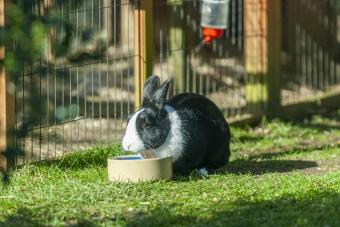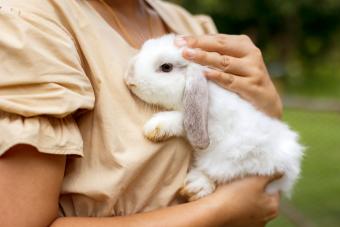
Wild rabbits are not suited for life as pets. While wild rabbits appear to be cute and cuddly, they should not be handled, and being too close could even damage to their physical and mental health. Wild rabbits also have very specific dietary needs and require a great deal of space. To top it off, it's illegal in most states to care for a wild rabbit without a wildlife rehabilitation license.
Legal Concerns Regarding Wild Rabbits

Keeping a wild rabbit as a pet is illegal in most jurisdictions in the United States. The reason ownership of wild rabbits is prohibited is because it is inhumane. Wild rabbits cannot be fully tamed or domesticated, and they will live with constant stress in a captive environment.
Wild rabbits can also carry diseases that are contagious to humans and pets. There are several rabbit species that are considered endangered, which means special measures must be taken to ensure the survival of the species. Even if you are legally able to keep a wild rabbit, a wild rabbit's specific requirements and how difficult they are to keep healthy should prevent you from trying.
The laws vary from state to state and even city to city, so you need to check with your local authorities before deciding to keep a wild rabbit.
Specific Requirements of Wild Rabbits
Wild rabbits are much different from domesticated pet rabbits. They look similar, but they do not do well in captivity.
- Diverse nutrition. Unlike domesticated rabbits, wild rabbits can't survive on a diet of rabbit pellets and the occasional chunk of romaine lettuce. Wild rabbits eat grasses, shrubs, leaves and bark, as well as seeds and berries. If they don't get enough greens in their diet, they may become ill or even die from nutritional deficiencies.
- Fiber from natural elements: Wild rabbits need to consume items that will help push through their digestive system. In the wild, they are able to find what they need. However, in captivity, this can prove difficult. Without elements to help digestion, wild rabbits could develop a blockage leading to death.
- Need for space. Wild rabbits are very sensitive to stress, and if they do not have enough space or other resources, they can quickly become sick or even die. For example, one of the instincts wild rabbits have is called "flight distance," which basically means how far away from danger an animal will allow itself to be before it runs away or fights back. If a predator gets too close, the prey animal will either fight or flee. If they don't have the option to do either, this could result in the rabbit becoming overstressed and going into cardiac arrest.
Understanding the Risks of Handling Wild Rabbits
Before you approach a wild rabbit, you need to be aware of the risks associated with them. Of course, they will not attack you unprovoked, but you should be aware of how they can harm you should they feel threatened.

Defense Against Predators
Wild rabbits are usually not aggressive. In fact, many people enjoy watching these creatures in their natural habitat. However, there are times when a wild rabbit will behave aggressively toward humans and even bite them. You are, after all, considered a predator to a small prey mammal. While this may not seem like a big deal, keep in mind that wild rabbits can carry and transmit diseases to humans.
Wild rabbits are not domesticated animals and should never be handled by children or adults who do not know how to approach them. Wild rabbits are fast and strong, and they have sharp teeth that can inflict significant damage if the animal feels threatened.
A wild rabbit can also harm you with their powerful back feet and will do whatever is necessary to escape you.
Wild Rabbits Can Threaten Domestic Rabbits
There are two diseases that are rarely seen in domesticated rabbits, but are seen in wild rabbits more frequently. These cannot be spread to humans, but they are dangerous for domesticated rabbits.
- Myxomatosis: This virus attacks lymphoid tissue, including the lymph nodes and spleen, and causes tissue swelling and skin ulceration with haemorrhages. It spreads easily from rabbit to rabbit through direct contact with infected animals or their droppings. The disease affects both wild and domestic rabbits alike, although it's less likely to occur in domesticated pet rabbits.
- Viral hemorrhagic disease: Also known as VHD, this is a highly contagious viral disease of wild rabbits that causes mortality rates of up to 100% in rabbit populations. It can be seen in pet rabbits, but it is most common in wild rabbits. The virus causes lesions on the liver, lungs, kidneys and spleen of infected animals, resulting in hemorrhaging. This condition can be spread to dogs and cats in the household, as well.
People who handle wild rabbits should wear protective gloves to prevent these potentially fatal conditions from spreading to pets. If you suspect your pet has been too close to a wild rabbit, especially if they have been bitten, take them to a veterinarian immediately for an examination.
It Isn't Possible to Domesticate Wild Rabbits

It is not possible to fully tame or domestic a wild rabbit. Even if you find a wild rabbit as a baby, their instincts to avoid predators will remain intact. This means you will never be able to build a bond with a wild rabbit. They won't be domesticated, they will simply be partially tame, at best.
A tame animal is one that has been habituated to humans, or at least its wild instincts have been significantly reduced. A domesticated animal is one that has been selectively bred for human companionship and assistance in work. Domestication does not occur over a period of months, but rather through generations of breeding for specific traits.
Take a look at the domesticated dog versus the wild wolf. Although a wolf can be tamed, they do not possess the same characteristics as a Pug, for example.
Contact Your Local Wildlife Rehabilitator
If you stumble upon a wild rabbit and they don't appear to be ill or injured, let them be. Some people also mistakenly find a rabbit's nest and don't see the mother around, so they will grab the babies in an effort to save them. As long as the nest goes unbothered, the mother will come back for her babies. You can keep an eye on the nest from a distance, but leave the nest alone.
If you do find a rabbit that is ill or injured, contact your local wildlife rehabilitation clinic. If you aren't sure where one is, you have other options, including:
- Humane Society: Check out the Humane Society's State-by-State listing of licensed rehabilitators.
- National Wildlife Rehabilitators Association: There is a map available showing the licensed rehabilitators across the nation associated with NWRA.
- Fish and Wildlife. Contact your local fish and wildlife commission to determine what to do next.
Choose Pet Rabbits
Domesticated rabbits make better pets than wild ones. Domesticated rabbits are bred for companionship, so they are usually friendly and loyal toward their owners. They also do not carry the same diseases as wild rabbits do, so there is very little risk of contracting an illness from them. Domesticated bunnies have been selectively bred over hundreds of years to produce a wide variety of colors and markings, and with proper socialization, they thrive with their human companions.







